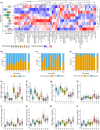Identification of aging-associated immunotypes and immune stability as indicators of post-vaccination immune activation
- PMID: 36081314
- PMCID: PMC9577949
- DOI: 10.1111/acel.13703
Identification of aging-associated immunotypes and immune stability as indicators of post-vaccination immune activation
Abstract
Immunosenescence describes immune dysfunction observed in older individuals. To identify individuals at-risk for immune dysfunction, it is crucial to understand the diverse immune phenotypes and their intrinsic functional capabilities. We investigated immune cell subsets and variation in the aging population. We observed that inter-individual immune variation was associated with age and cytomegalovirus seropositivity. Based on the similarities of immune subset composition among individuals, we identified nine immunotypes that displayed different aging-associated immune signatures, which explained inter-individual variation better than age. Additionally, we correlated the immune subset composition of individuals over approximately a year as a measure of stability of immune parameters. Immune stability was significantly lower in immunotypes that contained aging-associated immune subsets and correlated with a circulating CD38 + CD4+ T follicular helper cell increase 7 days after influenza vaccination. In conclusion, immune stability is a feature of immunotypes and could be a potential indicator of post-vaccination cellular kinetics.
© 2022 The Authors. Aging Cell published by Anatomical Society and John Wiley & Sons Ltd.
Conflict of interest statement
None declared
Figures






References
-
- Aiello, A. , Farzaneh, F. , Candore, G. , Caruso, C. , Caruso, C. , Davinelli, S. , Gambino, C. M. , Ligotti, M. E. , Zareian, N. , & Accardi, G. (2019). Immunosenescence and its hallmarks: How to oppose aging strategically? A review of potential options for therapeutic intervention. Frontiers in Immunology, 10, 2247–2247. - PMC - PubMed
-
- Alpert, A. , Pickman, Y. , Leipold, M. D. , Rosenberg‐Hasson, Y. , Ji, X. , Gaujoux, R. , Rabani, H. , Starosvetsky, E. , Kveler, K. , Schaffert, S. , Furman, D. , Caspi, O. , Rosenschein, U. , Khatri, P. , Dekker, C. L. , Maecker, H. T. , Davis, M. M. , & Shen‐Orr, S. S. (2019). A clinically meaningful metric of immune age derived from high‐dimensional longitudinal monitoring. Nature Medicine, 25, 487–495. - PMC - PubMed
-
- Andre, F. E. , Booy, R. , Bock, H. L. , Clemens, J. D. , Datta, S. K. , John, T. J. , Lee, B. W. , Lolekha, S. , Peltola, H. , Ruff, T. A. , Santosham, M. , & Schmitt, H.‐J. (2008). Vaccination greatly reduces disease, disability, death and inequity worldwide. Bulletin of The World Health Organization, 86, 140–146. - PMC - PubMed
-
- Anon Clinical Trials register (n.d.)‐ Search for 2019–000836–24. Available at: https://www.clinicaltrialsregister.eu/ctr‐search/search?query=2019‐00083...
Publication types
MeSH terms
Substances
LinkOut - more resources
Full Text Sources
Research Materials

